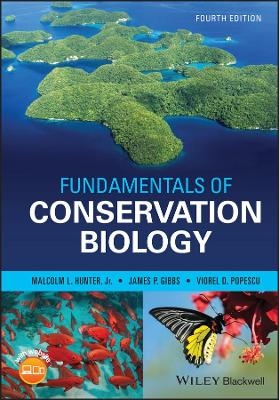
Fundamentals of Conservation Biology
Wiley-Blackwell (Verlag)
978-1-119-14416-8 (ISBN)
For more than 30 years, Fundamentals of Conservation Biology has been a valued mainstay of the literature, serving both to introduce new students to this ever-changing topic, and to provide an essential resource for academics and researchers working in the discipline. In the decade since the publication of the third edition, concerns about humanity’s efforts to conserve the natural world have only grown deeper, as new threats to biodiversity continue to emerge.
This fourth edition has taken into account a vast new literature, and boasts nearly a thousand new references as a result. By embracing new theory and practice and documenting many examples of both conservation successes and the hard lessons of real-world “wicked” environmental problems, Fundamentals of Conservation Biology remains a vital resource for biologists, conservationists, ecologists, environmentalists, and others.
Malcolm L. Hunter, Jr. is the Libra Professor of Conservation Biology at the University of Maine and the former President of the Society for Conservation Biology. James P. Gibbs is Distinguished Professor of Conservation Biology at the State University of New York College of Environmental Science and Forestry, and Conservation Scientist at the Galapagos Conservancy. Viorel D. Popescu is Assistant Professor of Conservation Biology at Ohio University, Athens and Research Associate at University of Bucharest’s Center for Environmental Research, Romania.
List of Case Studies ix
Preface x
Acknowledgments xiii
About the Companion Website xiv
Part I Biodiversity and Its Importance 3
1 Conservation and Conservation Biology 4
What is Conservation? 4
A Brief History of Conservation 6
An Overview of Conservation Ethics 10
What is Conservation Biology? 13
A Brief History of Conservation Biology 15
Summary 19
2 What is Biodiversity? 21
Species, Genes, and Ecosystems 22
Structure and Function 23
Measuring Biodiversity 24
The Mismeasure of Biodiversity 26
Biodiversity and Spatial Scales 26
Biodiversity Verbs 30
The Related Concepts of “Integrity” and “Sustainability” 31
Summary 33
3 Species Diversity 35
What is a Species? 35
How Many Species Are There? 37
The Intrinsic Value of Species and Their Conservation Status 39
The Instrumental Values of Species 46
The Uniqueness Value of Species 62
Summary 65
4 Ecosystem Diversity 67
What is an Ecosystem? 67
The Values of Ecosystems 71
Ecosystem Diversity and Species Diversity 80
Ecosystems and Landscapes 85
Summary 88
5 Genetic Diversity 90
What is Genetic Diversity? 90
The Importance of Genetic Diversity 101
Processes That Diminish Genetic Diversity 110
Cultural Diversity 117
Summary 124
Part II Threats to Biodiversity 129
6 Mass Extinctions and Global Change 130
Extinction Episodes of the Past 131
Estimating the Current Rate of Extinction 135
The Recent History of Global Climate Change 139
How Did We Get to this Point? What is the Way Ahead? 150
Summary 152
7 Extinction Processes 154
Why Are Some Species More Vulnerable to Extinction than Others? 154
Populations 161
Population Viability Analysis 166
Summary 177
8 Ecosystem Degradation and Loss 179
Contamination 183
Roads, Dams, and Other Structures 189
Earth, Fire, Water 195
Deforestation 198
Desertification 204
Draining, Dredging, Damming, Etc. 206
Fragmentation 211
Summary 221
9 Overexploitation 223
The Long History of Overexploitation 223
Types of Exploitation 230
Consequences of Overexploitation 238
Some Final Perspectives on Exploitation 243
Summary 249
10 Invasive Exotics 251
How Do Species Move? 252
Impacts of Invasive Exotics 261
Success Rates 269
Irony 271
Summary 277
Part III Maintaining Biodiversity 279
11 Protecting Ecosystems 280
Reserve Selection 281
Reserve Design 290
Reserve Management 299
Summary 307
12 Sustaining Ecosystems 309
Forestry 310
Livestock Grazing 316
Fisheries 322
Ecological Management 325
Restoring Ecosystems 325
Summary 337
13 Managing Populations 338
Providing Resources 339
Controlling Threats 348
Direct Manipulations 364
Epilogue 376
Summary 378
14 Conservation near People 381
Cultivated Ecosystems 382
Built Ecosystems 391
Zoos and Gardens 396
The Ex Situ–In Situ Interface 405
Conservation of Domesticated Species 410
Summary 414
Part IV The Human Factors 419
15 Social Factors 420
Values Differ 420
Describing Values 431
Values Change 434
Summary 443
16 Economics 445
The Benefits 446
The Costs 456
The Distribution of Benefits and Costs 459
Problems and Solutions 461
Summary 481
17 Politics and Action 483
Setting Priorities for Action 483
Rights and Responsibilities 493
International Agencies 496
Governments 501
Nongovernmental Organizations 505
Corporations 508
Communities 510
Individuals 512
Summary 517
Epilogue 520
Glossary 522
Literature Cited 536
Species Index 631
Subject Index 643
| Erscheinungsdatum | 01.04.2019 |
|---|---|
| Verlagsort | Hoboken |
| Sprache | englisch |
| Maße | 175 x 256 mm |
| Gewicht | 1386 g |
| Themenwelt | Naturwissenschaften ► Biologie ► Ökologie / Naturschutz |
| Naturwissenschaften ► Geowissenschaften ► Geologie | |
| ISBN-10 | 1-119-14416-7 / 1119144167 |
| ISBN-13 | 978-1-119-14416-8 / 9781119144168 |
| Zustand | Neuware |
| Haben Sie eine Frage zum Produkt? |
aus dem Bereich


